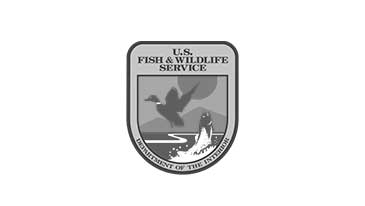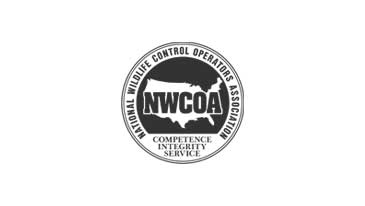Getting Rid of a Racoon
Do you have a raccoon problem near your property? Get rid of raccoons for good with Varment Guard!
Raccoon Biology
Common Name: Raccoon
Scientific Name: Procyon lotor
- Adult body length (without tail): 18 to 28 inches
- Adult body weight: 5 to 35 pounds
- Gestation period: 63 days
- Litters per year: 1
- Litter size: 2 to 7 young (usually 3 to 5)
- Breeding season: February through March
- Birthing season: April through May
- Age at which young are weaned: 2 to 4 months
- Activity period: Night
- Range: 3 to 20 square miles
- Primary foods: Meats, fish, pet food, seeds, insects, fruits, vegetables
Animal Control: Raccoon Prevention & Exclusion
At Varment Guard, we have a team of experts with the knowledge and tools needed for proper raccoon removal services.
Not only are our services effective in solving your raccoon problem, our ecologically sound methods and humane approach reduce stress on the animal during the removal process. Varment Guard offers:
- Raccoon Trapping & Removal
- Raccoon Exclusion & Prevention
- Raccoon Damage Repair and Inspection of Entry Points
HOW TO GET RID OF RACCOONS
Raccoon Live Trapping
Live trapping raccoons needs to be done by a professional wildlife control team. This is crucial in performing the task correctly and keeping the animal safe.
Live-Catch Wire Cage Traps
Trapping is the preferred method of removal of raccoons, most commonly by the use of live-catch wire cage traps. These traps are baited with a variety of scents raccoons find irresistible (fish, peanut butter, bacon, apple, peach, and berry, for example). Once baited, the traps are placed on the exterior of the home near the point of entry. Traps are checked daily by one of our technicians. During this check, captured animals are removed, traps are re-baited, and adjustments are made to trap placement.
Funnel Traps
Varment Guard technicians are also equipped and trained with funnel-style traps. These traps are placed directly over the point of entry to catch any animals as they leave. This method is successful for stubborn or when trapping shy animals.
Population Control Trapping
An over-abundance or high population of raccoons can be addressed through population control trapping. Baited traps are set along established trails, fence lines, buildings, or other cover used to move throughout the property.
This reduces the risk of raccoons tearing into your home, rummaging through your trash cans, and eating fish from landscape ponds. It also reduces the risk of exposure (people and pets) to the many diseases raccoons can carry.
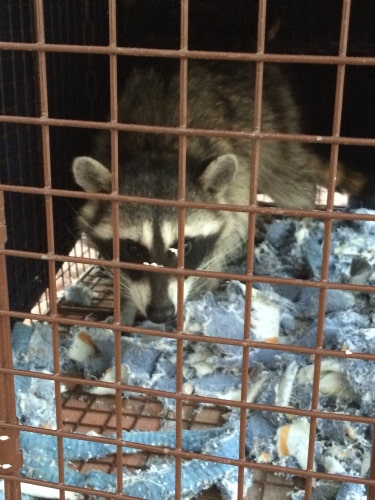
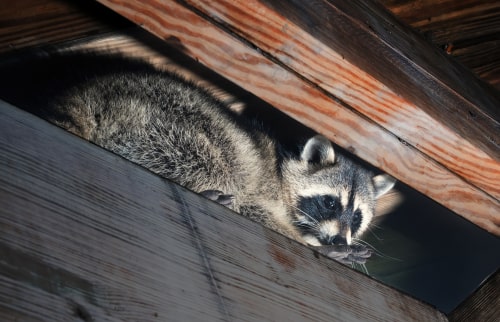
Raccoon Exclusion
Raccoons frequently attempt to create a home in attic spaces and can wreak havoc on insulation. They also commonly seek shelter under decks, porches, sheds, and in chimneys.
Raccoons should be prevented from entering structures by exclusion. Exclusion is a method of preventing animals from entering a structure by installing preventative materials to restrict access points.
Gable vents, soffit vents, and ridge vents can be screened with heavy duty hardware cloth or Ridge-Guard©. Power fans and hat vents can be covered with low profile metal mesh covers. Dormer, corners, roof junctions, siding, roof sheathing, and soffits can all be repaired with the use of metal and caulk. Chimney caps can be installed on open flues. For raccoons going underneath a deck, porch, or shed, buried wire can be installed. All exclusion and prevention installations come with a 5-year warranty.
Raccoon Springtime Removal
Raccoons breed mainly during the late winter to early spring, typically bearing litters of 3-5 young (also known as “kits”) once per year, around February to March. Signs of raccoons with kits present are chattering, squealing, and growling noises that can be heard from the interior of a structure, such as your attic or chimney. This can happen during the day or night, and you may be able to hear more than one at a time. A strong odor may be present in your house, especially if there are raccoon kits present. Most female raccoons will have kits during the springtime, and it is rare to come across one without a litter of kits during this time.
If you suspect or are currently dealing with raccoons with a litter of kits present, schedule a service today and get in touch with one of our expert wildlife technicians so they can help you properly assess and manage your raccoon problems.
Raccoon Behavior & Health Risks
Although raccoons can easily be scared away much of the time, when cornered they can pose a danger to humans and domestic pets. A few of the problems that raccoons can cause include:
Lawn Destruction
Raccoons can be destructive to lawns due to a propensity for “grubbing” behavior. Areas of sod in a lawn can be torn up overnight as a result of raccoon grubbing.
Damage to Entry Points
Raccoons often gain access into attics, basements, and crawl spaces by forcing open loose or broken vent covers, louvers, windows, and carpentry. Raccoons readily invade attics or enter uncapped chimney flues often as a place to birth and wean thor litters of pups.
Fleas and Ticks
Since raccoons are often infested with ticks and various fleas, human occupants and their animal companions can be infested.
Diseases
Raccoon feces accumulate and cause odor and secondary pest problems. They also serve as a potential source of raccoon roundworm infection. Raccoons have been implicated in several other infectious diseases transmissible to humans including leptospirosis, Chagas’ disease, tularemia, and, most notably, rabies.
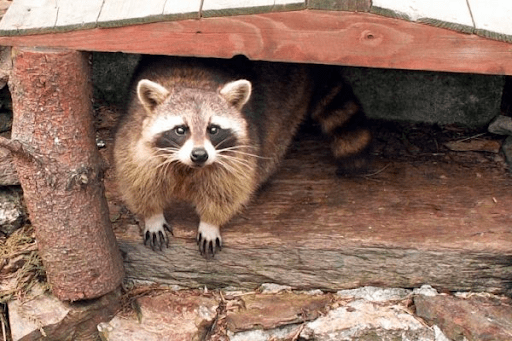
Varment Guard in Action
We are a Certified Installer of RidgeGuard© and XclusionPro from AAC-ProLine™
Ridge-Guard® is a system for guarding against animal entry at the roof ridge. Installation of Ridge-Guard® eliminates the need in most cases of removing old ridge vents. It stops pests without the need for tear-offs of ridge vent or ridge caps. See an example below:
BEFORE
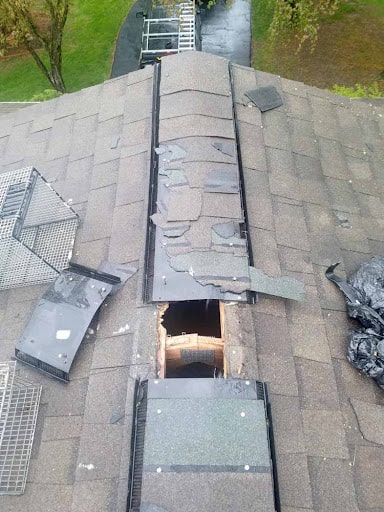
The initial damage was caused by a raccoon gaining access into the attic. Varment Guard replaced damaged shingles and ridge vents prior to installation of Ridge-Guard©.
AFTER
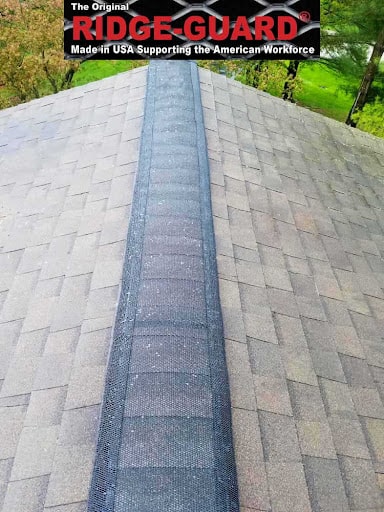
Ridge-Guard© is installed to prevent further entry from nuisance wildlife, like raccoons.
We can rid you of raccoon problems safely and efficiently!
Frequently Asked Questions:
How Can I Keep Raccoons Out of My Garbage?
Four ways you can raccoon-proof your garbage this winter include tying down your garbage can lids, keeping your garage door closed, sealing your trash bags, and rinsing out disposables before throwing them away. Learn more!
How Can I Prevent Raccoons this Spring?
Keep all garbage you take outside in sealed plastic bags; make sure they don’t leak or smell and tie down the lids of your garbage cans with bungee cords. Clean out your dumpster about once every two months in order to prevent smells or residue. Install strong wire mesh screens under your porch to keep them out. Learn more!
What Do Raccoons Do in Winter?
Raccoons spend most of the winter in their dens. However, they do emerge every few weeks to forage for food and drink water. Raccoons are opportunistic foragers; they want food that is easy to find… and lots of it! Learn more about what raccoons do in the winter!
Why Do Raccoons Keep Coming Back?
If you’ve been dealing with raccoons for quite some time and you can’t seem to shake them, it’s probably because they can find food in or near your home. Eliminating food sources (like unsecured trash) could deter raccoons from setting up shop at your home.
How to Scare Away Raccoons At Night
Do you have raccoons creeping around your property at night eating trash and damaging your lawn? Here’s how to keep raccoons away from your house at night:
- Install motion-activated sprinklers in your lawn
- Secure your trash cans or put them in a garage at night
- Don’t keep pet food outside
- Get a fence in your yard to keep raccoons out

